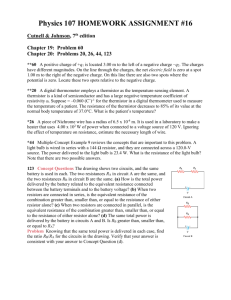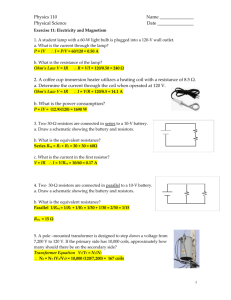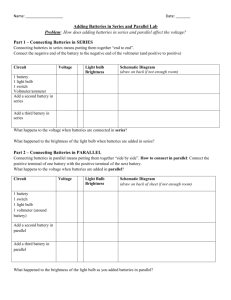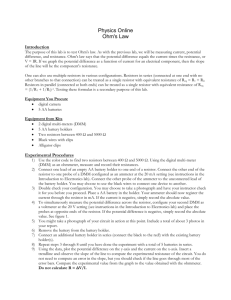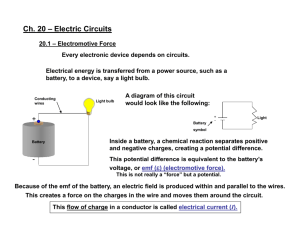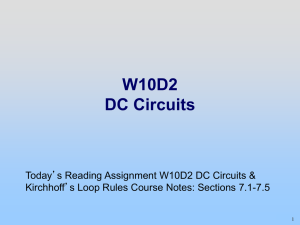PHYS 222 Worksheet 11 Energy and Power in Circuits ANSWERS
advertisement
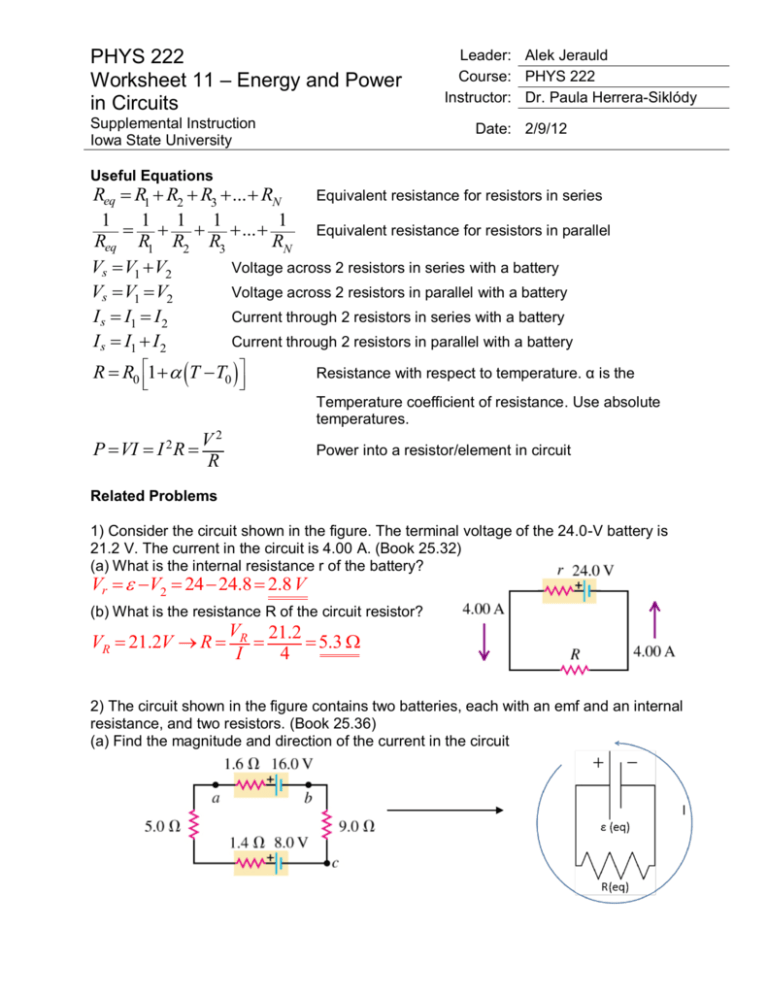
PHYS 222 Worksheet 11 – Energy and Power in Circuits Supplemental Instruction Iowa State University Leader: Alek Jerauld Course: PHYS 222 Instructor: Dr. Paula Herrera-Siklódy Date: 2/9/12 Useful Equations Req R1 R2 R3 ... RN Equivalent resistance for resistors in series 1 1 1 1 1 Equivalent resistance for resistors in parallel ... Req R1 R2 R3 RN Voltage across 2 resistors in series with a battery Vs V1 V2 Voltage across 2 resistors in parallel with a battery Vs V1 V2 Current through 2 resistors in series with a battery I s I1 I 2 Current through 2 resistors in parallel with a battery I s I1 I 2 R R0 1 T T0 Resistance with respect to temperature. α is the Temperature coefficient of resistance. Use absolute temperatures. P VI I 2 R V2 R Power into a resistor/element in circuit Related Problems 1) Consider the circuit shown in the figure. The terminal voltage of the 24.0-V battery is 21.2 V. The current in the circuit is 4.00 A. (Book 25.32) (a) What is the internal resistance r of the battery? Vr V2 24 24.8 2.8 V (b) What is the resistance R of the circuit resistor? VR 21.2V R VR 21.2 5.3 I 4 2) The circuit shown in the figure contains two batteries, each with an emf and an internal resistance, and two resistors. (Book 25.36) (a) Find the magnitude and direction of the current in the circuit eq 16 8 8 V Req 1.6 5 1.4 9 17 I eq Req 8 0.47 A 17 (b) Find the terminal voltage Vab of the 16-V battery VT 16 (0.47)(1.6) 15.25 V (c) Find the potential difference Vac of point a with respect to point c Va,c Va Vc 8 1.4(0.47) 5(0.47) 11 V 3) An idealized voltmeter is connected across the terminals of a 15.0-V battery, and a 75.0Ω appliance is also connected across its terminals. If the voltmeter reads 11.3 V. How much power is being dissipated by the appliance? What is the internal resistance of the battery? (Book 25.52) + V r - e =15 V R=75 VR 11.3 V VR 2 11.32 1.70 W R 75 V I R 0.151 A R V VR 15 11.3 r r 26.5 I I 0.151 PR 4) An idealized ammeter is connected to a battery as shown in the figure (Book 25.34) (a) Find the reading of the ammeter 10 I 5 A r 2 (b) Find the current through the 4.00-Ω resistor I 0 A (c) Find the terminal voltage of the battery V 0V 5) When switch S in the figure is open, the voltmeter V of the battery reads 3.11 V. When the switch is closed, the voltmeter reading drops to 2.96 V, and the ammeter A reads 1.65 A. Assume that the two meters are ideal, so they don't affect the circuit. (Book 25.37) (a) Find the emf Since the switch is open no current goes through the lower branch. The voltmeter is ideal, so no current runs through the meter, thus current through internal resister is zero. This means there is no voltage loss across the internal resistor: V1 3.11V 3.11 V (b) Find the internal resistance of the battery V2 2.96V I 1.65 A V2 rI r V2 I 0.09 (c) Find the circuit resistance R V2 is also the voltage across R: R V2 1.79 I 6) A typical small flashlight contains two batteries, each having an emf of 1.50 V connected in series with a bulb having a resistance of 17 Ω. (Book 25.54) (a) If the internal resistance of the batteries is negligible, what power is delivered to the bulb? P eq 2 R 0.53 W (b) If the batteries last for a time of 5.1 h, what is the total energy delivered to the bulb? E Ptsec onds (0.53)(5.1)(3600) 9700 J (c) The resistance of real batteries increases as they run down. If the initial internal resistance is negligible, what is the combined internal resistance of both batteries when the power to the bulb has decreased to half its initial value? (Assume that the resistance of the bulb is constant. Actually, it will change somewhat when the current through the filament changes, because this changes the temperature of the filament and hence the resistivity of the filament wire.) (r is the total internal resistance. R is the original resistor ) P'R P0 2 1 ( eq ) 2 R 2 ( )2 eq R eq 2R rR 1 1 2 2 r R 2R 2 I f 2R r 2 1 R 7.04



